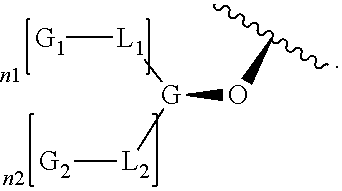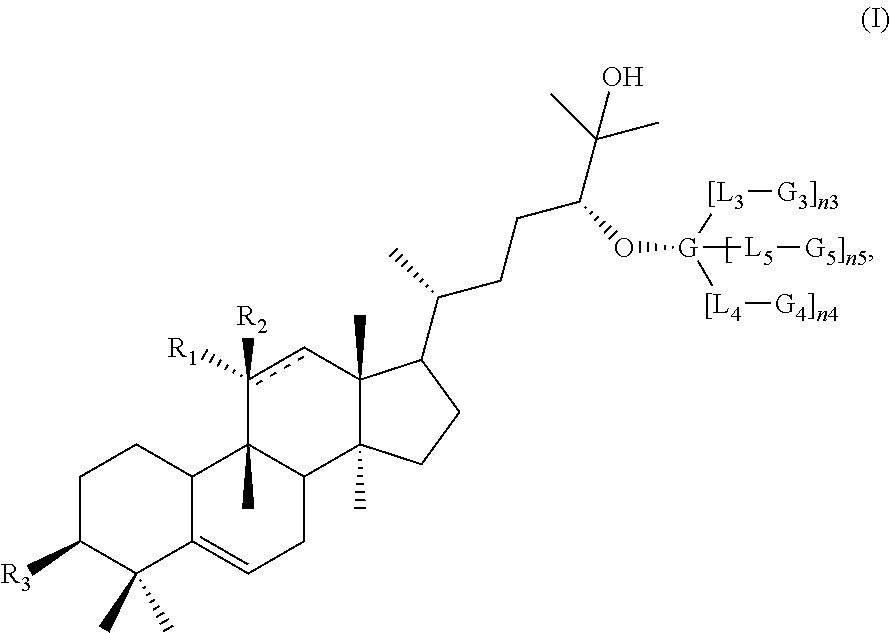High intensity sweeteners
a high-intensity sweetener and sweet taste technology, which is applied in the field of sweet tasting compounds and sweet taste enhancers, can solve the problems of delayed onset and lingering sweetness of high-intensity sweeteners such as sucralose and aspartame, and the biochemical basis of taste perception is poorly understood, so as to increase the sweetness of a food or beverage product and increase the sweetness of the food or beverage produ
- Summary
- Abstract
- Description
- Claims
- Application Information
AI Technical Summary
Benefits of technology
Problems solved by technology
Method used
Image
Examples
example 1
of Mogroside V
[0465]
[0466]A powdered extract of Siraitia grosvenorii (Fructus momordicae extract, 50% mogroside, light yellow powder) was obtained from Xi'an Heking Bio-tech Co., Ltd. Samples of about 1.00 g were carefully weighed and dissolved in 7.0 mL of water and split into 2 equal injections. A total of 60 injections were run in this manner with a combined weight of 30.0 g of the Fructus momordicae extract. Purifications were done on a Waters Auto-purification system using Atlantis T3 C18 column (5×10 cm) with an ACN / water gradient. The method was t=0 min., 1%, 50 mL / min→t=0.75 min., 1%, 100 mL / min; t=2.00 min., 1%, 100 mL / min; t=2.10 min., 10%, 100 mL / min; t=30.1 min., 30%, 100 mL / min; t=30.2 min., 95%, 100 mL / min; t=35.2 min, 95%, 100 mL / min; t=35.3 min., 1%, 100 mL / min; t=42.3 min., 1%, 100 mL / min by collecting from 20.0 min. to 30.8 min. (36 fractions, 30 mL each). The desired compound was eluted in fractions 16 and 17. These FractionFractions were pooled and removed the so...
example 2
and Enzymatic Production of Siamenoside I
[0468]
[0469]Isolation:
[0470]100 g of Siraitia grosvenorii powdered extract (Fructus momordicae extract, 50% mogrosides, light yellow powder) was obtained from Xi'an Heking Bio-tech Co., Ltd. was fractionated on C18 HPLC (5×10 cm Atlantis prep T3 OBD column, 5 um, Waters) by 200 injections using an A / B gradient (A=water B=acetonitrile) of 10→30% B over 30 minutes, with a 95% B wash, followed by re-equilibration at 1% (total run time=42 minutes). Each run was collected in 36 tared tubes (12 fractions / plate, 3 plates per run) at 30 mL / fraction. The plates were dried in the Genevac HT12 / HT24. The desired compound was eluted in Fraction 21 along with other isomers. The pooled Fraction 21 (3.3g) was further fractionated in 47 runs on fluoro-phenyl HPLC column (3×10 cm, Xselect fluoro-phenyl OBD column, 5 um, Waters) using an A / B gradient (A=water, B=acetonitrile) of 15→30% B over 35 minutes, with a 95% B wash, followed by re-equilibration at 15% (t...
example 4
of Iso-Mogroside V
[0480]
[0481]180 g of Siraitia grosvenorii powdered extract (Fructus momordicae extract, 50% mogrosides, light yellow powder) was obtained from Xi'an Heking Bio-tech Co., Ltd. was fractionated on C18 HPLC (5×10 cm Atlantis prep T3 OBD column, 5 um, Waters) by 360 injections using an A / B gradient (A=water, B=acetonitrile) of 10→30% B over 30 minutes, with a 95% B wash, followed by re-equilibration at 1% (total run time=42 minutes). Each run was collected in 36 tared tubes (12 fractions / plate, 3 plates per run) at 30 mL / fraction. The plates were dried in the Genevac HT12 / HT24. The desired compound was eluted in Fraction 19 along with other isomers. The pooled Fraction 19 (3.6 g) was further fractionated in 49 runs on Hilic HPLC column (3×10 cm, XBridge amide column, 5 um, Waters) using an A / B gradient (A=3:1 MeOH:H2O, B=acetonitrile) of 80 to 20% B over 22 minutes, with a 95% A wash followed by re-equilibration at 80% (total run time=30.3 minutes). Each run was collec...
PUM
 Login to View More
Login to View More Abstract
Description
Claims
Application Information
 Login to View More
Login to View More - R&D
- Intellectual Property
- Life Sciences
- Materials
- Tech Scout
- Unparalleled Data Quality
- Higher Quality Content
- 60% Fewer Hallucinations
Browse by: Latest US Patents, China's latest patents, Technical Efficacy Thesaurus, Application Domain, Technology Topic, Popular Technical Reports.
© 2025 PatSnap. All rights reserved.Legal|Privacy policy|Modern Slavery Act Transparency Statement|Sitemap|About US| Contact US: help@patsnap.com



